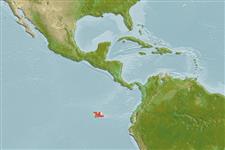>
Ovalentaria/misc (Various families in series Ovalentaria) >
Pomacentridae (Damselfishes) > Chrominae
Etymology: Azurina: Latin, azurinus = blue, pale blue; the name of Leuciscus caeruleus, blue Roach; 1600 (Ref. 45335).
Environment: milieu / climate zone / depth range / distribution range
Ecologie
marien rifbewoner; standvastig; diepte 5 - 30 m (Ref. 28023). Tropical; 1°N - 1°S
Eastern Central Pacific: Cocos and the Galapagos Islands. This species has not been seen since the 1982/83 El Niño event (Ref. 27438).
Grootte / Gewicht / Leeftijd
Maturity: Lm ? range ? - ? cm
Max length : 15.0 cm SL mannelijk / geslacht onbekend; (Ref. 28023)
Korte beschrijving
Determinatiesleutels | Morfologie | Morfometrie
Dorsale stekels (totaal) : 13; Dorsale zachte stralen (totaal) : 10 - 11; Anale stekels: 2; Anale zachte stralen: 11 - 12. Color olive-gray with a light-blue tint, silver on the ventral side; snout dusky, a black spot at pectoral fin base; pale gray pelvic and anal fins, dusky dorsal fin. Body more slender compared to other Galápagos damselfish. Preorbital bone smooth without a notchlike projection; edge of preopercle irregular, weakly serrate. Lateral line complete and conspicuous (Ref. 28023).
Apparently this species prefers open water near drop-offs, although individuals are found in a variety of inshore habitats to depths of 30 meters. It is not a common species and resident aggregations have strong preferences for specific sites. Feeds mainly on plankton in the water column, usually in heterotypic aggregations with Chromis atrilobata. Oviparous, distinct pairing during breeding (Ref. 205). Eggs are demersal and adhere to the substrate (Ref. 205). Males guard and aerate the eggs (Ref. 205). Prior to the 1982-83 El Niño, a small aggregation frequented the shallow water just west of Pinnacle Rock at Bartolomé. But despite intensive observations during the decade after this event, no records of this species were made (Ref. 28023).
Levenscyclus en paargedrag
Maturiteit | Voortplanting | Paaien | Eieren | Fecunditeit | Larven
Oviparous, distinct pairing during breeding (Ref. 205). Eggs are demersal and adhere to the substrate (Ref. 205). Males guard and aerate the eggs (Ref. 205).
Grove, J.S. and R.J. Lavenberg, 1997. The fishes of the Galápagos Islands. Stanford University Press, Stanford, 863 p. (Ref. 28023)
Status op de Rode Lijst van het IUCN (Ref. 130435: Version 2024-1)
Gevaar voor de mens
Harmless
Gebruik door de mens
Tools
Speciale rapporten
Download XML
Internetbronnen
Estimates based on models
Preferred temperature (Ref.
123201): 23.7 - 24.5, mean 23.9 °C (based on 9 cells).
Fylogenetische diversiteitsindex (Ref.
82804): PD
50 = 0.7500 [Uniqueness, from 0.5 = low to 2.0 = high].
Bayesian length-weight: a=0.01259 (0.00571 - 0.02773), b=3.03 (2.84 - 3.22), in cm total length, based on LWR estimates for this (Sub)family-body shape (Ref.
93245).
Trofisch niveau (Ref.
69278): 3.4 ±0.45 se; based on food items.
Weerstandsvermogen (Ref.
120179): Gemiddeld, minimale populatieverdubbelingstijd 1,4-4,4 jaar (Preliminary K or Fecundity.).
Fishing Vulnerability (Ref.
59153): Low vulnerability (10 of 100).
